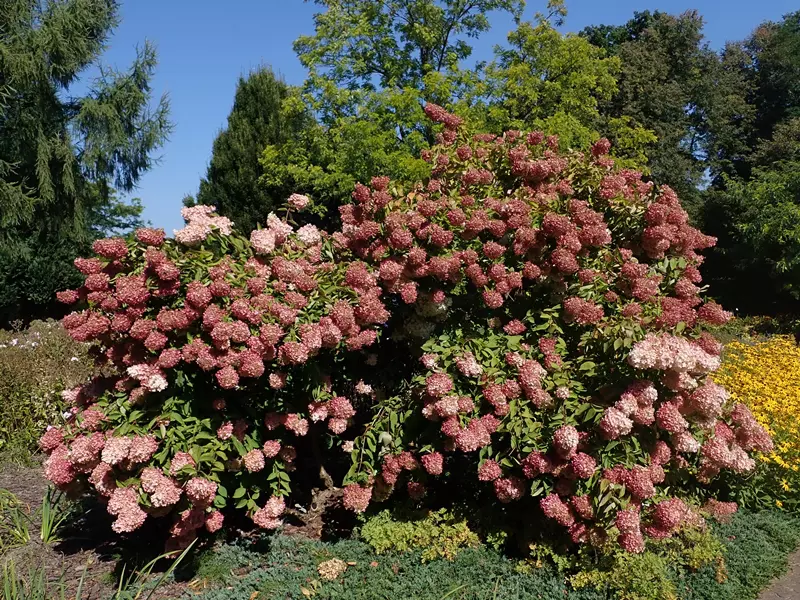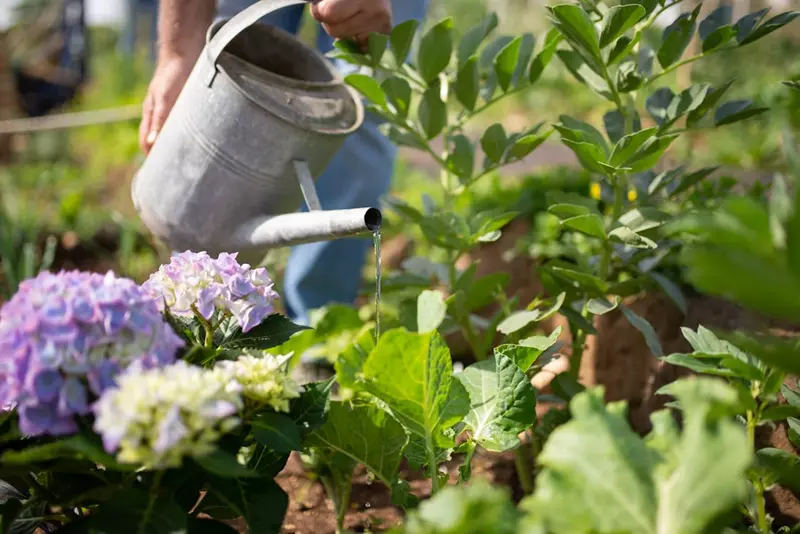
Hydrangea Planting and Care: A Comprehensive Guide
A comprehensive guide on planting and caring for hydrangeas, covering site selection, soil preparation, planting steps, watering, fertilising, pruning, and pest management.
Read MoreHydrangeas are cherished for their vibrant blooms and lush foliage, making them a favourite in many gardens. However, it's not uncommon for gardeners to encounter drooping or wilting hydrangeas, which can be both concerning and unsightly. Understanding the underlying causes and implementing effective solutions is essential to maintain the health and beauty of these plants.

Water stress occurs when a plant's water intake is insufficient or excessive, disrupting its physiological balance. In hydrangeas, this imbalance can lead to drooping leaves and flowers, signalling distress.
Hydrangeas thrive in consistently moist soil. When deprived of adequate water, they exhibit signs of stress:
To prevent underwatering:

While hydrangeas require ample water, overwatering can be detrimental:
To avoid overwatering:
Several environmental conditions can exacerbate water stress in hydrangeas:
Early detection of water stress is crucial:
By maintaining balanced watering practices and considering environmental factors, gardeners can prevent water stress, ensuring hydrangeas remain healthy and vibrant.
Sunlight is essential for photosynthesis, the process by which plants produce energy. However, the intensity and duration of sunlight exposure can significantly impact hydrangea health. Both excessive and insufficient sunlight can cause stress, leading to drooping and other issues.
Hydrangeas, particularly the bigleaf varieties, prefer morning sun and afternoon shade. Excessive exposure to intense afternoon sunlight can lead to:
While hydrangeas can tolerate partial shade, too little sunlight can also be detrimental:
To prevent drooping caused by improper sunlight exposure, consider the following guidelines:
Beyond sunlight exposure, other environmental factors can influence hydrangea health:
By understanding and managing sunlight exposure, gardeners can prevent drooping in hydrangeas, ensuring these plants remain healthy and continue to enhance garden landscapes with their beauty.
Hydrangeas require soil that retains adequate moisture yet drains well to prevent waterlogging. Poor drainage can cause:
To enhance drainage:
Maintaining consistent soil moisture is vital for hydrangea health. Both drought and overwatering can lead to drooping:
To manage soil moisture effectively:
Soil pH influences nutrient availability and can affect hydrangea health:
Maintaining appropriate soil pH ensures nutrient availability, promoting robust growth and reducing the likelihood of drooping.
Compacted soils impede root growth and water infiltration, leading to hydrangea stress and drooping:
Encouraging healthy root development through proper soil management supports plant stability and reduces drooping incidents.
By understanding and optimising soil conditions, gardeners can effectively prevent drooping in hydrangeas, ensuring these plants remain healthy and continue to enhance garden landscapes with their beauty.
While nitrogen promotes leafy growth, an excess can cause issues:
To prevent nitrogen excess:
Phosphorus is vital for root development and flower production. A deficiency can lead to:
To address phosphorus deficiency:
Potassium regulates water movement and strengthens plant tissues. A deficiency can cause:
To remedy potassium deficiency:
Magnesium is essential for chlorophyll production. A deficiency may lead to:
To correct magnesium deficiency:
Maintaining balanced nutrition is key to preventing drooping in hydrangeas:
By understanding and managing nutrient levels, gardeners can ensure their hydrangeas remain healthy, vibrant, and free from drooping caused by nutrient imbalances.
Several pests can infest hydrangeas, leading to drooping and overall decline:
Hydrangeas are susceptible to several diseases that can cause drooping:
Maintaining hydrangea health involves proactive management of pests and diseases:
By understanding the pests and diseases that affect hydrangeas and implementing effective management strategies, gardeners can prevent drooping and maintain the health and beauty of these beloved plants.
Hydrangeas thrive in consistently moist soil but are sensitive to both drought and overwatering. Striking the right balance is crucial:
Implementing proper watering techniques helps prevent drooping:
Soil quality directly affects water retention and drainage:
Identifying symptoms of improper watering can prevent drooping:
Environmental conditions influence watering needs:
By adhering to these proper watering practices, you can prevent hydrangea drooping and ensure your plants remain healthy and vibrant throughout the growing season.
Hydrangeas' sunlight requirements vary by species, but most prefer a balance between sun and shade:
Overexposure to sunlight can lead to:
To prevent hydrangea drooping due to improper sunlight exposure, consider the following strategies:
Regular observation is key to successful sunlight management:
By implementing these optimal sunlight management practices, you can prevent hydrangea drooping and ensure your plants remain healthy and vibrant throughout the growing season.
Hydrangeas require soil that retains moisture yet drains well to prevent waterlogging:
Soil pH affects nutrient uptake and bloom colour:
Consistent soil moisture is vital for preventing hydrangea droop:
Compacted soil restricts root growth and water infiltration:
Monitoring soil health ensures optimal growing conditions:
By implementing these soil management practices, you can prevent hydrangea drooping and promote vigorous growth and abundant blooms in your garden.
Hydrangeas can be classified based on their blooming habits, which influences pruning methods:
Proper timing is crucial to prevent drooping and ensure robust flowering:
Implementing appropriate pruning methods enhances plant strength and bloom quality:
Excessive pruning can weaken hydrangeas, leading to drooping:
In cases where pruning alone doesn't prevent drooping:
By adhering to these pruning techniques and considerations, you can enhance the structural strength of your hydrangeas, preventing drooping and ensuring a vibrant, flourishing display in your garden.
Wilting in hydrangeas can result from several issues:
Addressing wilting involves targeted interventions based on the identified cause:
To minimise the risk of wilting:
By accurately diagnosing the cause of wilting and implementing these remedies, you can restore your hydrangeas to their full, vibrant splendour, ensuring they remain a highlight of your garden.
Wilting leaves are often caused by water stress, heat, or nutrient deficiencies. Ensuring consistent watering and proper soil conditions can help.
To prevent drooping flowers, provide adequate water, ensure soil drainage, and support heavy blooms with stakes if necessary.
Water hydrangeas deeply 1–2 times a week, increasing during hot weather. Ensure soil remains consistently moist but not waterlogged.
Hydrangeas thrive in locations with morning sun and afternoon shade. Avoid direct exposure to intense afternoon sun.
Prune annually to remove dead or weak stems and shape the plant. Avoid over-pruning to maintain strong, supportive stems.
Hydrangeas prefer well-draining, nutrient-rich soil with a neutral to slightly acidic pH. Amend heavy soils with compost for better aeration.
Diseases like root rot, powdery mildew, and leaf spot can weaken plants and cause drooping. Proper care and fungicides can mitigate these issues.
Address the underlying cause—rehydrate, improve drainage, or treat diseases—and provide appropriate care to nurse the plant back to health.
Rain can weigh down blooms, causing them to droop. Supporting stems with stakes can prevent this, especially during heavy rainfall.
Hydrangeas require a balanced supply of nitrogen, phosphorus, and potassium. Avoid over-fertilising with nitrogen-heavy products to maintain strong stems.

A comprehensive guide on planting and caring for hydrangeas, covering site selection, soil preparation, planting steps, watering, fertilising, pruning, and pest management.
Read More
Learn the best practices for watering hydrangeas to ensure vibrant blooms and healthy plants. Discover how often to water, seasonal tips, and common mistakes to avoid.
Read More
Discover the benefits and techniques of using diatomaceous earth for hydrangeas. Learn how to apply DE effectively for pest control and soil improvement.
Read More